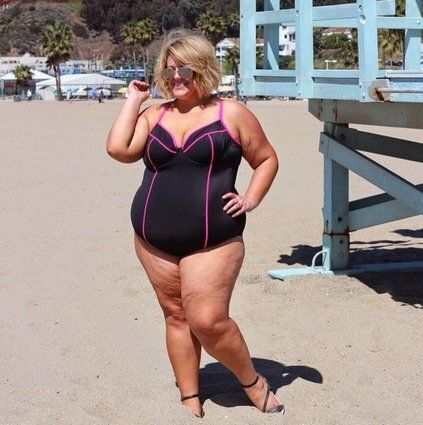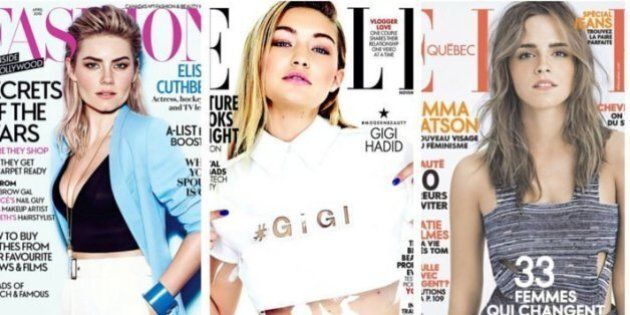
Mainstream beauty standards are rough when you’re a person of colour. Growing up, I had to deal with aunts who would pinch my round, Filipino nose to make it slimmer. Kids would ask why my multi-creased eyelids didn’t look like "other Asians," and I would repeatedly explain why to them, TLC-style: No, I’ve never had surgery; No, I wasn’t trying to look like them.
I’d hear stories from family and friends who used to wash their faces with stinging lemon juice to make their skin whiter, or who would edit their selfies to make themselves look paler.
It's a fact of life that your hair is always something to be touched or commented on. Clothes in nude shades are never actually your nude.
So it was brilliant to see the fashion industry begin to embrace inclusive representation in 2015, and the multitude of body types that came with that acceptance. Eight black women seemed to epitomize a diversity tipping point when they appeared on several major U.S. magazine covers in September.
Trans visibility, brought to the forefront by celebrities like Laverne Cox, was bolstered by Caitlyn Jenner’s Vanity Fair cover in July. Curvy models like Ashley Graham headlined campaigns and magazine covers across the United States.
Along with HuffPost Canada Style, I wanted to see if a similar diversity "boom" was being mirrored on Canadian newsstands.
Although print media has been dwarfed by the digital age, magazine covers are still relevant. Since the early 1900s, magazines have deliberately used models on their covers to entice readers. It was only in the 1960s, when Cosmopolitian introduced teasing headlines on their covers, that words became important to the cover equation.
Today, cover models remain symbolic declarations of a magazine’s identity. They capture who’s important in society or "breaking the Internet" (see Kim Kardashian’s racially insensitive Paper cover). And they sometimes make history; Jenner's coming out will always be linked to her iconic white silk bodysuit and Vanity Fair's brand.
And for its best fashion magazine covers of 2015 contest, the American Society of Magazine Editors chose mesmerizing covers featuring Venus Williams and Lupita Nyong’o as its top finalists.
Knowing all this, I was hopeful that 2015 was the year Canadian fashion magazine covers would reflect our country’s diverse mix.
But that’s not what I found at all.
The Mission
The first question: Which magazines should we look at?
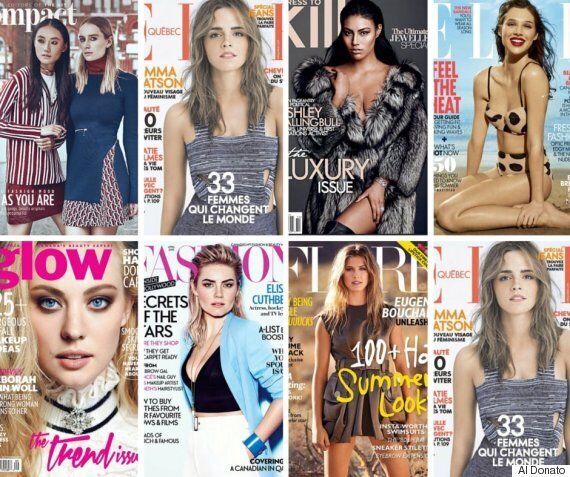
We decided to restrict our survey to the most popular fashion or style-focused magazines from 2015. Most were monthly or seasonal and were widely available across Canada. All were written in English, except for two in French. All covers, including variations or special edition covers, were counted. Only issues that could be found in back issue archives or online were included.
We chose 10 well-known magazine brands: Flare, LouLou, Fashion, Elle Canada, Elle Quebec, Pure, Glow, Dress to Kill, Sharp, and The Kit Compact.
I didn’t include special interest and niche magazines that were lower in circulation, as they would not accurately reflect the mainstream media industry’s outreach to general audiences. However, I found niche magazines that targeted specific demographics, such as South Asian women, featured people of colour on almost every cover.
What did we mean by "diversity"?
We knew we wanted to look at representation on Canada’s magazine covers. But what kind of representation were we talking about?
I chose to use the term "person of colour" to define individuals who are from non-white descent, and "white" to describe people of Caucasian, European descent. I included people with mixed heritages and those of non-European descent in the people of colour group. And this is where it started to get complicated.
I grappled with the definition of "race." Because race is a social construct that depends on culture and location, a glance at a magazine cover can’t be all that determines if a person is white. For example, individuals who may "look white" but come from non-European descent, like Jennifer Lopez, counted as people of colour. When the cover star’s ethnic identity was known or searchable online, I could categorize them with certainty. Often, I’d end up sleuthing through cover models' biographies, playing a (well-intentioned) race detective. But when I couldn't find any info, I had to rely on how they presented and referred to themselves as. Because of this, my count of "white" cover stars might include white-passing individuals who actually identify otherwise.
On LGBTQ representation
In an attempt to collect data on other forms of diversity, I realized my terminology would have to be specific. Since there is no one way someone can be transgender or intersex, and because many trans individuals face barriers that prevent them from being public about their identities, I could only look for "openly trans" representation on covers.
And similarly, because sexuality is fluid and sometimes met with opposition, other LGBQ representation also meant cover stars who publicly identified as such.
I found myself cringing as I typed in names in search bars, along with words like "orientation," "is gay," "is queer," "girlfriend," "dating history," or "personal life." Instead of concrete statements from the celebrities or models themselves, I’d see rumours about their sexualities from other sites.
Visible disabilities (emphasis on "visible")
I included visible disabilities in my search, because disability representation is lacking in the fashion industry.
A "visible disability" means one that can be seen or identified by others, so the use of a wheelchair or having a mobility impairment could qualify as a visible disability, for example.
But many disabilities are "invisible," such as deafness, cognitive or mental health disorders, and brain injuries, among others. So some cover stars might be living with disabilities, but readers (myself included) can't tell from the cover unless it's identified in text or through another means.
Then came the question of body size...
I didn’t seek to compare different sizes on magazine covers. Although representation of diverse body sizes is important, deciding which cover stars qualified felt too subjective. The term plus-size is something that not everyone agrees with, so it wasn’t something I was willing to use in the research.
The Results
After surveying 10 leading fashion magazines in Canada, here’s what I found:
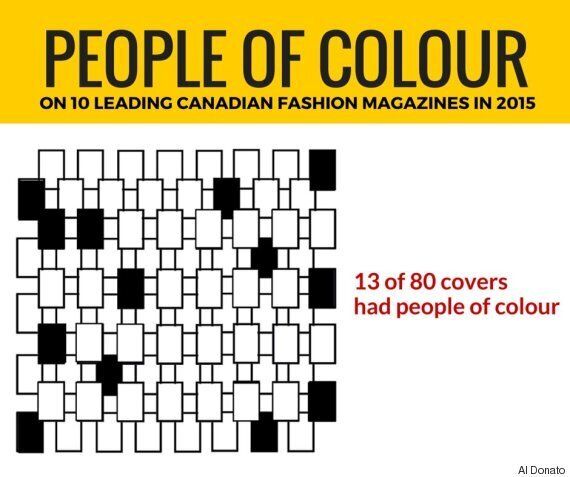
- Of the 124 people featured on 80 covers published in 2015, only 13 could be identified as people of colour. Seven cover stars were black, three were Asian, two were Latina, and one was indigenous.

- White or white-passing people were featured on 95 per cent of covers, landing on 76 of the 80. Some magazine brands had no identifiable people of colour on their covers for the entire year, while others had one person of colour featured in group covers with white models.
- LouLou had the highest number, with six people of colour featured on five of their eight covers in 2015. However, they all appeared on covers alongside white models.
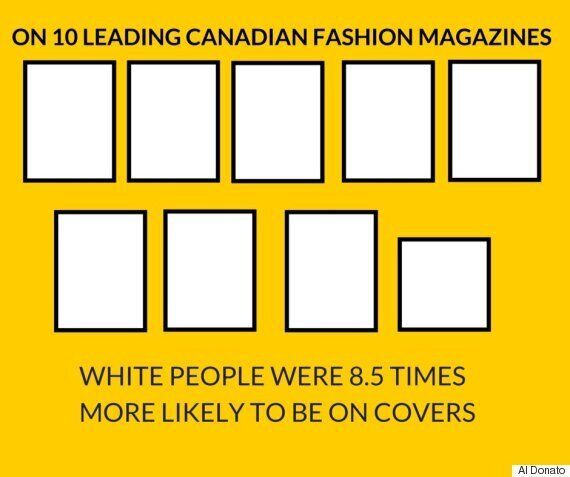
Of the 13 people of colour, 10 of them were featured in group covers with either one or more white fellow cover stars. Guess that old notion that racialized people can't sell magazines is still alive and well.

- From the cover stars I could search, none publicly identified as gay, lesbian, bisexual or queer.
- Openly trans people were missing on 2015 covers in Canada. Cis women appeared to be well-represented.
- Men were rarely spotted on fashion magazines, and those that were on covers were more likely to be older than the twenty-something women featured. When it came to age, five male cover stars could be verified to be more than 40 years old, whereas only two female cover stars were. Just one man was a person of colour.
- People with visible disabilities were not given any visibility, nor were any mobility devices like wheelchairs, hearing aids, or guide animals. Even eyeglasses were rarely shown on covers, or any item that would suggest cover stars were anything but able-bodied.

- An obvious trend I noticed was that there were barely any variations in body size on covers. Most models looked thin enough that they could buy clothes from mainstream brands without having to worry about fit or tailoring.
The Verdict
It wasn't hard to spot the pattern. When it comes to representation and inclusion, Canadian fashion covers have a long way to go.
The dearth of fashion media diversity on is not unique to our country. In spite of the black women who dominated September's covers, Fashionista found that just 27 of 136 U.S. fashion magazine covers printed in 2015 had models of colour. Worldwide, the Fashion Spot reports that more than 22 per cent of fashion magazines in 2015 had people of colour on their covers, a slight increase from the year before, when white people were five times more likely than people of colour to appear on international covers.
Jourdan Dunn, who was Prada’s first black model in a decade and Vogue UK’s first black cover model in 12 years, told the Guardian there's no good reason for not choosing black cover models.
"They say if you have a black face on a magazine cover it won’t sell, but there’s no real evidence for that. It’s lazy," Dunn said. "You always hear 'there aren’t enough black models,' which is BS. It’s all about these dead excuses."
Considering Canada’s sizable racialized population, those excuses don't hold water here, either. Statistics Canada reports that as of 2011, more than 6.2 million Canadians are non-white visible minorities, out of Canada’s 35.16 million population. That's more than 19 per cent of our country who could easily be visible in the media they consume, which is plenty: ZenithOepedia estimated Canadians spent about 492 minutes consuming media in 2015.
And lack of representation is bound to have an effect on them. University of Toronto professor Minelle Matani's research into minorities in Canadian media showed that misrepresentation of ethnic groups led to normalizing stereotypes.
"Often unequipped with direct experience of Canadian cities given the sheer vastness of this nation, Canadians rely upon the media to tell them about their country," Matani reports. "... Through demeaning characterizations and an absence of
nuanced representations, minorities are made to feel as if they do not belong."
And no representation at all suggests that diverse lives aren't as important or deserving of attention. Omitting people of colour from a specific form of entertainment, for example, gives the message that racially diverse individuals aren't as beautiful or as wanted as the beautiful qualities white individuals have.
I've seen the impact of underrepresentation first-hand, in the form of internalized self-hatred, nose-pinching and so forth. I've also seen the benefits of reversing this. My sister, who'd lament her skin colour as a kid, now berates her friends who layer on ghostly pale layers of foundation that don't match their skin colour. Cousins of mine turn to non-Western forms of entertainment, like K-Pop, to see idols who look a little more like them take centre stage.
The Takeaway
With 2015 behind us, 2016’s covers so far aren’t impressing me much. Of the Canadian January issues I've seen, all five of the cover stars on four magazine covers are white.
What I’ve uncovered about the lack of diversity in this industry tells me fashion magazines aren’t meant for people like me. I’m tempted to feel like my efforts to discover diversity were futile, but in retrospect, delving into the covers made me think critically about diversity.
I was consciously scanning and re-scanning the covers, because cover stars' ethnicities were a lot more complicated than the average consumer might see. There were subsets to whiteness too, like Jewish representation and mixed heritage representation, that were lost in the sea of identical features. A hurried look at a newsstand would have most people see them as white. The nuances were lost.
I really doubt any of these magazines were deliberately using models and celebrities because they were white. Chances are, there are people of colour working in fashion media too, people from diverse backgrounds who grew up consuming the same media I have. What’s really at fault is complacency with industry traditions, the internalizing and acceptance of the “That’s just the way it is” reasoning we've all heard ad nauseum.
If that’s the case, those with editorial power need to learn how to be consciously aware of what status quo their cover stars are maintaining or disrupting. Showing different people on covers, and not just in group shots or once a year, takes a deliberate and continuing commitment to inclusion. It’s a plunge that can make cover imagery more complex and more nuanced.
And once they make that move, people like me might start double-taking when we pass by. On my daily commute, as I did my ritual of scanning magazine racks (and then ignoring them all), I noticed a battered issue of NOW, a Toronto weekly paper that had done the unthinkable: it had put a naked, laughing, black woman on its cover.
ELLE U.S. appears to have listened to the uproar caused by their 2015 "Women in TV" issue's portrayal of a single woman of colour. Four of the five stars on the 2016 edition are women of colour, each with her own cover.

ELLE's example could pave the way for an encouraging trend of rewriting industry standards and using backlash as teachable moments. The fact that each woman of colour was given the same exposure white cover stars had in last year's issue suggests the magazine is thinking deeply about the kind of representation they're putting forward. In turn, I guarantee this will make people like me want to start reading.
So, what do you say, Canada?
ALSO ON HUFFPOST:
